 Facebook
Facebook
 X
X
 Instagram
Instagram
 TikTok
TikTok
 Youtube
Youtube
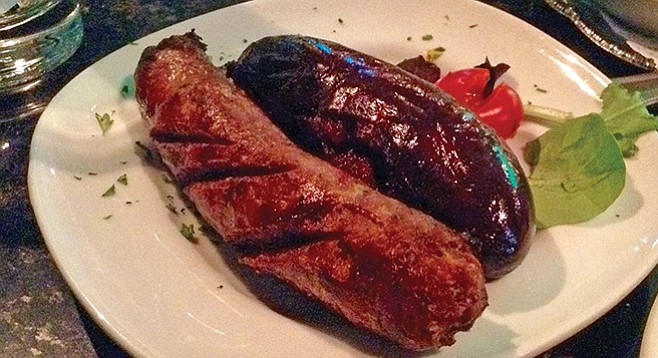
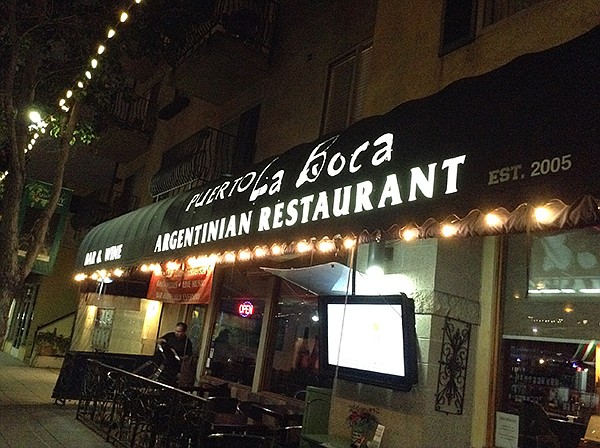
"I tell you,” says Patrick Brown, “San Diego has the most competitive happy hour on the whole coast. And I’ve researched happy hours from Seattle to San Francisco to L.A. We have the best.”
I’m thinking: Pat Brown?
“You related to any California governors?”
“No relation. Even though both Browns, Pat and Gerry, have been pretty good.”
Pat and Juan-José Rodriguez, “JJ,” are sitting up eating two-buck happy-hour empanadas here at the bar inside Puerto La Boca. I’m sitting at this black granite counter. Blue-and-white Argentinian flag’s on the wall to my left. (Why blue and white? To make it easy to distinguish from the Spanish red-and-yellow bandera during Argentina’s war for independence from 1810 to 1818.)
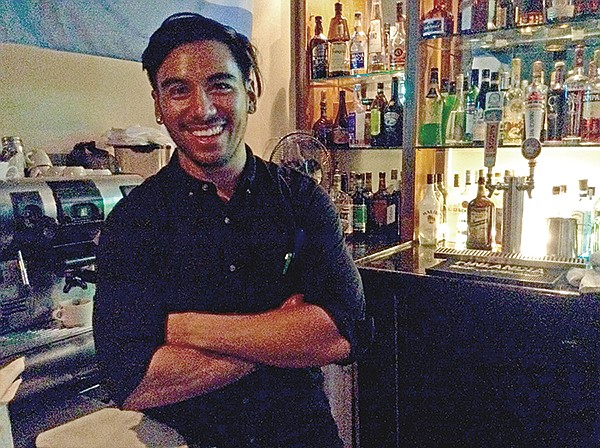
Gravelly voice of guy singing Spanish on the system, with beautiful passionate guitar work kinda sets the atmosphere. We’re in the land of tango. Roberta the barkeep says it’s Diego El Cigala, one of the great tango singers.
What Pat says about competitive happy hours holds up here. A glass of house red goes for $3. Can’t beat that. I go for a Malbec, the wine Argentina’s made famous. This is a Crotta, Mendoza 2013. “Argentinian wines are like the gauchos,” says Roberta. “Bold. More gutsy than, say, Chilean wines.”
I try it. Yes, plenty of guts. Could make a wine drinker of me. Especially at three buckeroos.
HH food choice is good, too. You have to choose among “starters.” Thirty percent off any of them. The list shows me one thing: Argentinian food is basically European settler food. No evidence of indigenous foods, as you get in the Mexican culinary line-up with its Mayan, Aztec foundations.
They have a dozen choices here, starting with empanadas. Pastry turnovers. Turns out empanadas were the Moors’ gift to Spain. Empanadas originated in the Middle East and India (think of their first cousins, samosas). Here you can get empanadas stuffed with beef, chicken, ham and cheese, spinach and cheese, or corn and cheese. Cost $2.95 each, but with that 30 percent off, $2.07. So I order up a beef one and a corn-and-cheese one from Nikko, the other barkeep. And then, chorizo, an Argentinian beef-and-pork sausage.
“It’s way different than our chorizo,” says Juan-José. He’s Mexican. “Ours is much fattier and hotter, and oozier.”
Whatever, a complete sausage here goes for $3.50, which becomes HH$2.45.
And of course now I spot the morcilla, some sort of Argentinian blood sausage. Same price. I add that to my order. I know those’ll fill me up.
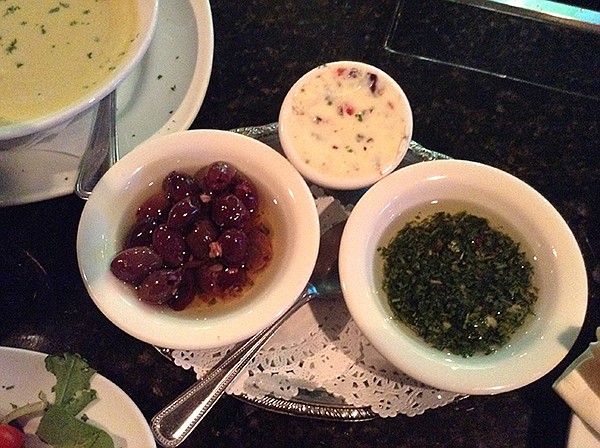
But there’s a bunch of stuff I long to go for, too: Mollejas al Jerez o a la Parilla. Sweetbreads (meat from the thymus gland and pancreas) sautéed in sherry or just grilled. Down from $9.95 to $6.97. Sautéed octopus, $7.67. Sautéed mussels in a white wine sauce ($8.37). And, oh yeah, “Matambre.” Means kill (mata) hunger (hambre), basically a stomach-stuffer. So, this Matambre con Rusa ($7.67) is slivers of beef rolled around spinach, egg, carrots, peas, and served with potato salad (“La Rusa.” Russia, seems, is the recognized potato-salad capital of the world).
I’ve ordered more than enough here. Problem? Can’t resist getting a soup, which turns out was not on HH. So, $3.95 just whipped the bill up from about $12 to $17, with tax. It is an asparagus soup, and fine, but nothing Argentinian that hits you. Still, the chorizo is one solid herby tight-packed sausage. The blood sausage has enough spices to not taste totally like blood. And the corn empanada has a delicate lusciousness about its mix of corn and cheese.
But the champ? Has to be the beef empanada. Beautiful, for starters, with a twirly column of pastry holding up one side, and golden crisp pan (bread) covering the meat. The meat’s nicely marinated. Not sure if it’s Argentinian meat, which is a pity because you hear all their beef is hormone-free, comes from grass-fed, free-range cattle whose meat is much leaner than ours and has more mineral flavors.
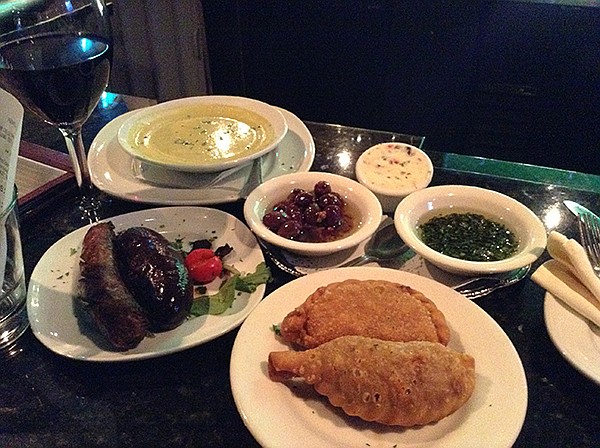
Makes me long to try one of their famous steaks, except, we’re talking 30 bucks for one of those babies. Besides, I remind myself I’m eating the virtual national dish with these empanadas. Some say they got popular because gauchos could hold them in one hand and eat as they chased cows over the pampas. Chomp ’n’ charge.
The other champs? The complimentary side dishes. Like the strong little black olives you get, along with a bowl of chimichurri. Chimichurri’s the ketchup of Argentina. “Argentinians put it over everything, especially grilled meats,” says Nikko. “They use it as a dip, too. It’s the national salsa.”
Nikko says the mix is parsley, garlic, olive oil, vinegar, chili flakes, salt, and pepper. Yes, flavor’s tame for a guy with a Baja border palate, but it still goes great with the bread.
I end up dipping chunks from the basketful of bread they include. It is dee-lish, and it fills all the spare corners down there in the spare tire.
Nikko’s cleaning the massive espresso machine as I leave. “Coffee the same in Buenos Aires?” I ask. “Well, yes, except Argentinians often ask for a lemon rind in their espresso,” he says. “It adds acid. They have very particular tastes.”
Huh. There’s something else for next time. ’Course, with espresso probably costing as much as a HH Malbec, I might never get to find out.
Happy Hour Prices: Empanadas (stuffed with beef, chicken, ham and cheese, spinach and cheese, or corn and cheese), $2.95 = $2.07 HH); chorizo (Argentinian beef and pork sausage), $2.45; Morcilla (Argentinian blood sausage), ($2.45); Mollejas al Jerez o a la Parilla (sweetbreads sautéed in sherry or grilled), $6.97; sautéed octopus, $7.67; sautéed mussels in white wine sauce, $8.37; matambre (rolled beef stuffed with spinach, egg, carrots, peas) plus potato salad, $7.67; house wine, $3; draft beer, $3.50
Hours: 11:30 a.m.–10:00 p.m. daily (till 11:00 p.m. Friday and Saturday); 1:00 p.m. – 8:30 p.m., Sunday
Happy Hours: 4:30–7:30 p.m., Monday thru Saturday; all day Sunday (bar area only)
Bus: 83
Nearest bus stops: India near Grape (northbound); Kettner near Hawthorn (southbound)
Trolley: Green Line



"I tell you,” says Patrick Brown, “San Diego has the most competitive happy hour on the whole coast. And I’ve researched happy hours from Seattle to San Francisco to L.A. We have the best.”
I’m thinking: Pat Brown?
“You related to any California governors?”
“No relation. Even though both Browns, Pat and Gerry, have been pretty good.”
Pat and Juan-José Rodriguez, “JJ,” are sitting up eating two-buck happy-hour empanadas here at the bar inside Puerto La Boca. I’m sitting at this black granite counter. Blue-and-white Argentinian flag’s on the wall to my left. (Why blue and white? To make it easy to distinguish from the Spanish red-and-yellow bandera during Argentina’s war for independence from 1810 to 1818.)

Gravelly voice of guy singing Spanish on the system, with beautiful passionate guitar work kinda sets the atmosphere. We’re in the land of tango. Roberta the barkeep says it’s Diego El Cigala, one of the great tango singers.
What Pat says about competitive happy hours holds up here. A glass of house red goes for $3. Can’t beat that. I go for a Malbec, the wine Argentina’s made famous. This is a Crotta, Mendoza 2013. “Argentinian wines are like the gauchos,” says Roberta. “Bold. More gutsy than, say, Chilean wines.”
I try it. Yes, plenty of guts. Could make a wine drinker of me. Especially at three buckeroos.
HH food choice is good, too. You have to choose among “starters.” Thirty percent off any of them. The list shows me one thing: Argentinian food is basically European settler food. No evidence of indigenous foods, as you get in the Mexican culinary line-up with its Mayan, Aztec foundations.
They have a dozen choices here, starting with empanadas. Pastry turnovers. Turns out empanadas were the Moors’ gift to Spain. Empanadas originated in the Middle East and India (think of their first cousins, samosas). Here you can get empanadas stuffed with beef, chicken, ham and cheese, spinach and cheese, or corn and cheese. Cost $2.95 each, but with that 30 percent off, $2.07. So I order up a beef one and a corn-and-cheese one from Nikko, the other barkeep. And then, chorizo, an Argentinian beef-and-pork sausage.
“It’s way different than our chorizo,” says Juan-José. He’s Mexican. “Ours is much fattier and hotter, and oozier.”
Whatever, a complete sausage here goes for $3.50, which becomes HH$2.45.
And of course now I spot the morcilla, some sort of Argentinian blood sausage. Same price. I add that to my order. I know those’ll fill me up.

But there’s a bunch of stuff I long to go for, too: Mollejas al Jerez o a la Parilla. Sweetbreads (meat from the thymus gland and pancreas) sautéed in sherry or just grilled. Down from $9.95 to $6.97. Sautéed octopus, $7.67. Sautéed mussels in a white wine sauce ($8.37). And, oh yeah, “Matambre.” Means kill (mata) hunger (hambre), basically a stomach-stuffer. So, this Matambre con Rusa ($7.67) is slivers of beef rolled around spinach, egg, carrots, peas, and served with potato salad (“La Rusa.” Russia, seems, is the recognized potato-salad capital of the world).
I’ve ordered more than enough here. Problem? Can’t resist getting a soup, which turns out was not on HH. So, $3.95 just whipped the bill up from about $12 to $17, with tax. It is an asparagus soup, and fine, but nothing Argentinian that hits you. Still, the chorizo is one solid herby tight-packed sausage. The blood sausage has enough spices to not taste totally like blood. And the corn empanada has a delicate lusciousness about its mix of corn and cheese.
But the champ? Has to be the beef empanada. Beautiful, for starters, with a twirly column of pastry holding up one side, and golden crisp pan (bread) covering the meat. The meat’s nicely marinated. Not sure if it’s Argentinian meat, which is a pity because you hear all their beef is hormone-free, comes from grass-fed, free-range cattle whose meat is much leaner than ours and has more mineral flavors.

Makes me long to try one of their famous steaks, except, we’re talking 30 bucks for one of those babies. Besides, I remind myself I’m eating the virtual national dish with these empanadas. Some say they got popular because gauchos could hold them in one hand and eat as they chased cows over the pampas. Chomp ’n’ charge.
The other champs? The complimentary side dishes. Like the strong little black olives you get, along with a bowl of chimichurri. Chimichurri’s the ketchup of Argentina. “Argentinians put it over everything, especially grilled meats,” says Nikko. “They use it as a dip, too. It’s the national salsa.”
Nikko says the mix is parsley, garlic, olive oil, vinegar, chili flakes, salt, and pepper. Yes, flavor’s tame for a guy with a Baja border palate, but it still goes great with the bread.
I end up dipping chunks from the basketful of bread they include. It is dee-lish, and it fills all the spare corners down there in the spare tire.
Nikko’s cleaning the massive espresso machine as I leave. “Coffee the same in Buenos Aires?” I ask. “Well, yes, except Argentinians often ask for a lemon rind in their espresso,” he says. “It adds acid. They have very particular tastes.”
Huh. There’s something else for next time. ’Course, with espresso probably costing as much as a HH Malbec, I might never get to find out.
Happy Hour Prices: Empanadas (stuffed with beef, chicken, ham and cheese, spinach and cheese, or corn and cheese), $2.95 = $2.07 HH); chorizo (Argentinian beef and pork sausage), $2.45; Morcilla (Argentinian blood sausage), ($2.45); Mollejas al Jerez o a la Parilla (sweetbreads sautéed in sherry or grilled), $6.97; sautéed octopus, $7.67; sautéed mussels in white wine sauce, $8.37; matambre (rolled beef stuffed with spinach, egg, carrots, peas) plus potato salad, $7.67; house wine, $3; draft beer, $3.50
Hours: 11:30 a.m.–10:00 p.m. daily (till 11:00 p.m. Friday and Saturday); 1:00 p.m. – 8:30 p.m., Sunday
Happy Hours: 4:30–7:30 p.m., Monday thru Saturday; all day Sunday (bar area only)
Bus: 83
Nearest bus stops: India near Grape (northbound); Kettner near Hawthorn (southbound)
Trolley: Green Line